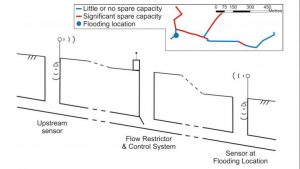Urban flooding: the benefits and drawbacks of AI flood prevention

After recent flooding devastating communities around the UK, Housing Industry Leaders sits down with Dr Will Shepard, postdoctoral research associate, to discuss what the CENTAUR project means for controlling urban flooding.

Dr Will Shepard, Postdoctoral research associate.
A lot of urban flooding originating from sewer systems occur due to large volumes of water moving from the top of catchment areas to the bottom of catchment areas in a short amount of time.
The CENTAUR programme aims to hold some of the rushing water back to reduce or eliminate the flooding at the bottom of the catchment through the use of data-driven real time controls (RTC). Dr Shepard explained: “The concept was to put some gates in the sewer at the top end of the catchment, so you can hold that water back if you’re at capacity during storm events and release it more gradually when the rain falls gone.”
AI has its uses but there are setbacks
New AI technologies are helping to plan for and prevent flooding, especially in urban areas.
Will emphasised: “The main role of the AI is a set of systems which defines how the gates move – so when the gates should open and close to store the water behind it. Rather than being binary yes or no, there are different levels so you can merge across. It allows us to do things more gradually and hopefully more effectively.”
While AI is helpful in the management of flooding, Will discussed the limits of AI in flood prevention.
AI needs the data to understand what it is doing. One of the problems this creates within floods is that they don’t necessarily occur that regularly
“There’s probably not a massive area but lots of little niches where AI could fit in and help flooding. AI needs the data to understand what it is doing. One of the problems this creates within floods is that they don’t necessarily occur that regularly. A lot of AI techniques are used with something that happens all the time rather than once every year or so.”
However, by using AI techniques you can run lots of different models to work out where to put the gates, enabling them to work to the best of their ability.
Proactive implementation prevents reactive responses
One of the ways in which urban flooding can be prevented is by stopping the water from getting into the sewers and storing it upstream, allowing for the water to infiltrate more naturally. Will explained by doing, this you are “mimicking the natural systems.”
However, this can create further issues. Will explained: “The developers don’t want to use some of the land they can build houses on for building ponds and so on. Then, there are also the questions of who owns the land and who maintains it moving forwards.”
This is why CENTAUR focused on implementing gates to help control the flow of water. Since the initial project, a secondary project has been implemented to expand the use of gates in flood prevention.

Diagram showing how the RTC works
Will told Housing Industry Leaders: “We managed to get the software that controls these gates embedded into the hydraulic modelling software that a lot of the water companies and their consultants use. So they can look at how they can install these gets within urban areas.”
Climate change not the sole reason for increased flooding
Naturally, climate change is causing more intense rainfall events and more rainfall at different times of the year. However, Will explained the role urbanisation plays in the increase of urban flooding. He said: “Even within the existing urban areas you are getting more people paving their driveways etc. The more of the land that is impermeable the fewer places the water has to go, so eventually runs off to the bottom of the catchment.
The more of the land that is impermeable the fewer places the water has to go, so eventually runs off to the bottom of the catchment
He added: “Combine this with sewer systems in some areas that have been there for 100 years or more. When you get a new build that connects to the sewer system you’ll have more water going into the sewer.”
Overall, AI seems to play more of a supportive role within urban flood prevention, rather than being the leading technical innovation, as is true with many other sectors.
